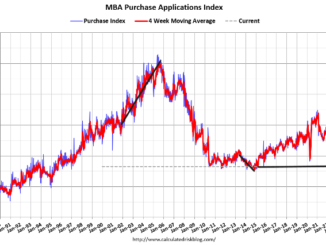
There are reasons California-based Pennymac may want to forget 2022.
The mortgage lender’s overall origination volume dropped 54% from January to September compared to the same period in 2021, according to data from Inside Mortgage Finance. The company has cut hundreds of jobs across layoffs in March, May, July and October, underscoring the immense challenges of the current mortgage markpany, which is the country’s largest correspondent aggregator, has invested in growing its correspondent footprint while some rivals, like its primary competitor, Wells Fargo, are pulling back or exiting entirely.
“Obviously, the way we’ll take advantage of it [competitors leaving the space] is we’ll step into that void,” Abbie Tidmore, senior managing director of Pennymac’s correspondent channel, told HousingWire. “We’ve got a scalable model so that we can pick that up in no time. And, as capacity leaves the space, that’ll give us a little more ability to push margins up.”
In fact, the correspondent channel is a relatively bright spot for a mortgage industry that’s had a devil of a time in 2022.
So far this year, the correspondent channel has gained market share on the two other channels, increasing from 23.4% of the total first-line originations in the fourth quarter of 2021 to 27.9% in the third quarter of 2022, according to IMF data. Meanwhile, the retail channel’s market share slipped to 56% of the overall originations pie in the third quarter of 2022. The wholesale channel, meanwhile, has held steady at about 16%.
There’s a reason the correspondent channel has grown during such a dark time for the mortgage industry. It relies on the small lenders’ production, such as community banks and independent mortgage banks that typically have a salesforce focused on working closely with local borrowers and real estate agents over the long haul.
That doesn’t mean the correspondent channel is immune to surging rates. Its production reached $141 billion in the third quarter of 2022, down 13% compared to the second quarter. The volume between January and September totaled $461 billion, down 42.3% year over year. Still, the channel has suffered less than the overall market, whose volume decreased by 22.3% in Q3, compared to Q2; and 45.4% from January to September, compared to the same period in 2021.
The correspondent channel has limitations in terms of margins, due to the fact that lenders need to pay the network of originators that they aggregate loans from. According to Moody‘s data, this channel’s average gain-on-sale margins reached 50 basis points in 2020 and were down to 20 basis points in the third quarter of 2022. To compare, retail was at 350 bps and wholesale about 70 bps in the third quarter.
Because the margins are so thin, correspondent lenders have to be fast, efficient, have strong liquidity positions and/or a good capital markets game.
One notable advantage the correspondent channel has in the current market is that the lenders are not fighting in the trenches of an aggressive price war, which brings margins down even further. United Wholesale Mortgage (UWM), both the top wholesale lender and overall mortgage originator in the country, significantly reduced prices this year to gain a competitive edge, sending wholesale competitors reeling.
“In the correspondent channel, you don’t have one player going forward and being very aggressive in pricing, impacting the overall sector,” said Warren Kornfeld, senior vice president of the financial institutions’ group at Moody’s.
Kornfeld said lenders need three things in a shrinking market: “Scale, efficiency and to be realistic, for example, about cutting costs.”
Is that what correspondent lenders are doing?
HousingWire interviewed executives of several top companies in the space to better understand their strategies, including Pennymac Financial, U.S. Bank Home Mortgage and Planet Home Lending. Each of those companies originated more than $15 billion in volume through the channel over the first three quarters of 2022.
Other top correspondent lenders – AmeriHome, Wells Fargo, Truist Bank, NewRez/Caliber and JPMorgan Chase – declined to comment
Stepping into the void
According to Tidmore, Pennymac aggregates loans from about 770 clients of all sizes in the 50 U.S. states. Tidmore said that the lender, which focuses on clients with robust purchase production, never pulled out of the market, and noted that once the loan is in-house, the acquisition process takes 10 days or less.
People we have a great relationship with are leaving their companies for whatever reasons, and we’ll have that connection.
Abbie Tidmore, senior managing director of Pennymac correspondent
Consequently, Pennymac’s correspondent channel market share increased from 13.6% in the first quarter of 2022 to 14.1% in the third quarter of 2022, signaling the start of a recovery to the heights hit in 2021, when it notched 16.7% market share in the channel.
Its correspondent channel originations totaled $66 billion from January to September, down 53.6% year over year, but was 72% higher than AmeriHome Mortgage, the second-largest lender in the space, according to IMF data. And, from July to September, Pennymac’s volume ticked up 6.7% compared to the second quarter.
Tidmore said it remains a tricky space to navigate. Some clients are exiting the space, closing doors or engaging in mergers and acquisitions.
“We clearly are not adding clients with the speed we used to,” she said.
Still, the executive sees opportunities: “As clients may be merging with another company that we’re not doing business with, we’ll look to sign them up as well. People we have a great relationship with are leaving their companies for whatever reasons, and we’ll have that connection.”
Another encouraging thing, according to Tidmore, is that margins, which began to free fall in early 2021 and bottomed out in the second quarter, began to rise in the third quarter.
“We are encouraged with what we’re currently seeing with margins at this time,” she said.
Losing space
Wells Fargo’s future in mortgages has been the subject of widespread industry speculation.
Since CEO Charlie Scharf came on board in the fall of 2019, the bank has been in the process of revamping its home loans business.
During Wells Fargo’s second-quarter 2022 earnings call this past July, it became clear that the company would lower its ambitions in mortgage. Scharf told analysts the bank is “not interested in being extraordinarily large in the mortgage business just for the sake of being in the mortgage business.”
Its strategy has impacted correspondent lending.
Bloomberg reported in August that the bank will likely shrink or eliminate the channel, citing unnamed sources. From January to September, Wells Fargo originated $37 billion in the space, a 27% decline compared to the same period in 2021. In the third quarter, originations were $9 billion, 38% lower than in the previous quarter, per IMF data.
Analysts at Keefe, Bruyette & Woods (KBW) published a report in August stating that if Wells does exit the correspondent lending market, it could benefit other big competitors, such as Pennymac, Amerihome (owned by Western Alliance Bancorp.) and New Rez/Caliber (Rithm Capital).
So far, AmeriHome Mortgage has captured second place in the correspondent lending space from Wells Fargo, according to IMF’s data. From January to September, the lender reached $38 billion in origination volume, which was actually down 36.4% compared to the same period in 2021. In the third quarter, production was $11.6 billion, a 12.6% decline compared to the previous quarter, but enough to give the company an 8.2% market share.
Price is an important ingredient in terms of being competitive to any client base, we’re certainly very competitive and we seem to be pretty stable in our pricing.
John Hummel, U.S. Bank executive vice president of correspondent and HFA lending
Credit ratings agency Fitch Ratings noted in a report that AmeriHome’s scalable business strategy focuses on generating gains by acquiring and selling mortgage loans.
“Using this gain, the strategy is scaled to minimize costs and create mortgage servicing rights at a discount to the market. The company selectively engages third-party vendors to leverage its cost advantages and optimize operations,” Fitch’s analysts wrote in the report.
Another depositary losing correspondent market share is JPMorgan Chase, which fell from the fifth position in the first quarter of 2022 to the sixth position in the third quarter. The bank’s originations in the channel reached $24.7 billion from January to September, down 51.5% from the same period in 2021.
NewRez/Caliber also dropped one position, falling from fourth to fifth in the same period. Its originations declined 54% year over year to $25.6 billion from January to September.
And, with a $26 billion in correspondent volume from January to September, Truist was down 9.8% compared to the same period in 2021 but is now the fourth-largest correspondent lender in the country.
Relying on technology
Minneapolis-based U.S Bank Home Mortgage was the rare bird among mortgage lenders in the third quarter. It not only posted an increase in origination volume, but a sizable one.
The mortgage lender originated $8.4 billion in mortgage loans through the correspondent channel between July and September, up 53% compared to the previous quarter, an increase no other top-25 correspondent lender could match. However, in the nine months of 2022, the lender reported a $20.3 billion volume, down 46% year over year.
So what changed in Q3?
Company executives said that, among other things, U.S. Bank is relying on technology upgrades to achieve greater performance, having moved to a new originations platform this year.
“Price is an important ingredient in terms of being competitive to any client base, we’re certainly very competitive and we seem to be pretty stable in our pricing,” John Hummel, the bank’s executive vice president of correspondent and HFA lending, said. “But on top of that, certainly, clients are looking for execution, or our ability to buy the loans at a right turn time.”
According to the company, over the last three months, it took less than five days from receiving a loan file from a correspondent partner to purchasing the loan.
U.S. Bank has a portfolio of 800 correspondent business clients nationwide, most of whom are focused on purchase loans. The bank, which has been in the correspondent channel for years, maintains a balanced mix of correspondent and retail lending – and the correspondent channel fluctuates between 45% and 50% of the overall production over time.
From January to September, U.S Bank had a 4.3% market share in the correspondent channel.
“We plan to continue to drive market share at a responsible economic return,” Hummel said.
Looking forward, Hummel said he expects that there will be some consolidation in the industry. “I think we’re already starting to see it. And we’ll probably continue to see it. But we still have very viable clients that sell to us today that certainly, they’re making adjustments to their business models as well.”
Growing via acquisitions
Connecticut-based Planet Home Lending was another lender to post origination gains in the third quarter.
So, you’ve got the ability to turn on and off fairly quickly, depending on trends. In retail, it’s more difficult to do so.
James Loving, Planet Home Lending’s senior vice president of correspondent sales
In addition, the mortgage servicer and lender, which started its correspondent program about eight years ago, was the only top U.S. correspondent aggregator to report an increase in production from January to September. Originations rose 6% to $18 billion compared to the same period in 2021, according to the IMF.
The reason why?
In April, the company agreed to acquire assets from Homepoint’s delegated correspondent channel for $2.5 million in cash. The move signals Homepoint’s exit from the correspondent channel to focus on wholesale, a space where competition has escalated in 2022.
By the beginning of September, Planet had already integrated 75% of Homepoint’s clients into its platform. In total, Planet has over 750 customers on the correspondent channel, claiming it can complete the acquisition of loans within six days.
“Starting in June, we closed down on the acquisition of the Homepoint delegated correspondent network, and that’s been very helpful,” James Loving, Planet’s senior vice president of correspondent sales, said. “But, of course, it’s always a learning process for customers moving from one program to another.”
According to Loving, Planet acquires niche products, such as manufactured housing and renovation loans, through its correspondent channel.
Loving said one bright spot on the correspondent channel is that companies can purchase the type of loans they want and improve their presence in regions of the country they are interested in. “So, you’ve got the ability to turn on and off fairly quickly, depending on trends. In retail, it’s more difficult to do so.”
The lender has over the years “taken the philosophy of not one-size-fits-all customers,” he says. When dealing with banks and credit unions, the company noticed that they might not be able to underwrite all loan types. So, Planet offers some non-delegated services, which provides more revenues amid tight margins. However, the price is still the “ticket to the dance,” according to the executive.
Loving said it is more costly for the company to offer new services as it has to build a structure and hire more employees, but “the benefits have paid off over the last few years.”
Planet has “seen the margins compress considerably throughout this year, but they seem to have stabilized here,” he said. “It all depends on how the Federal Reserve reacts.”



